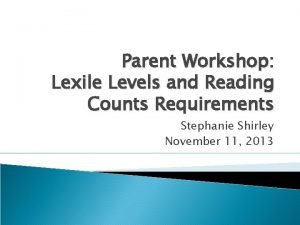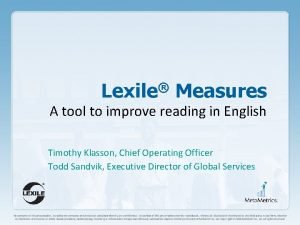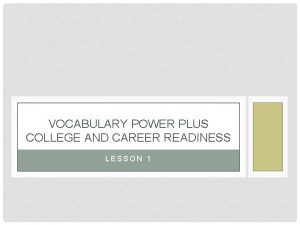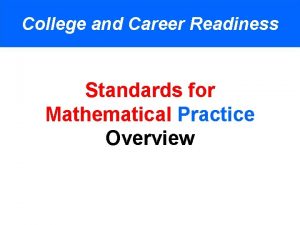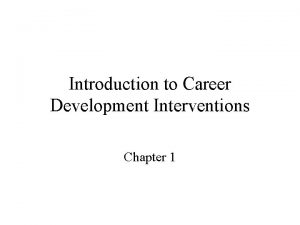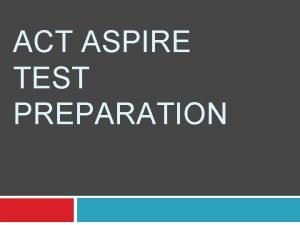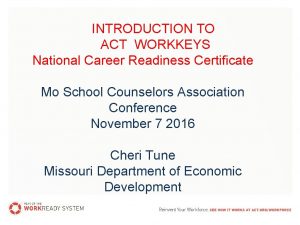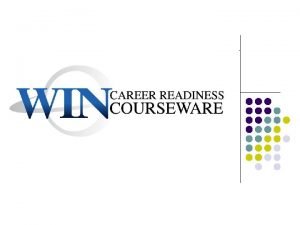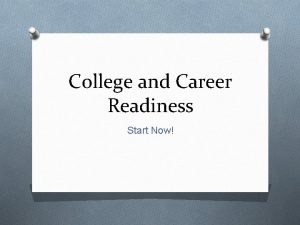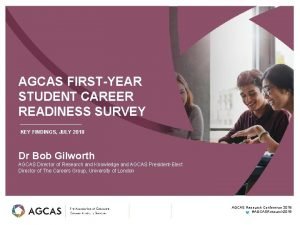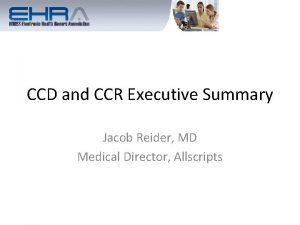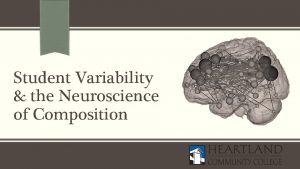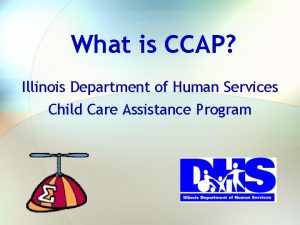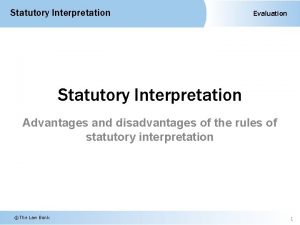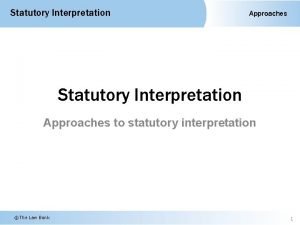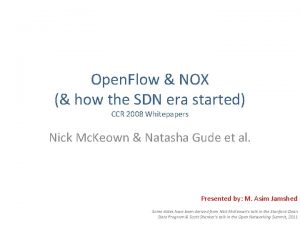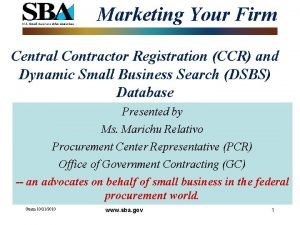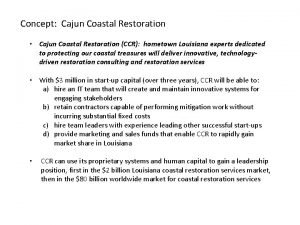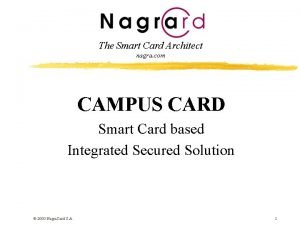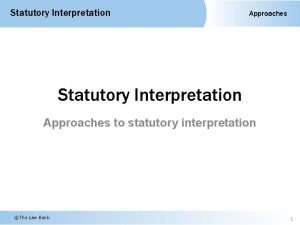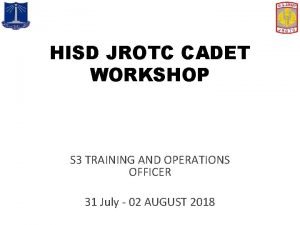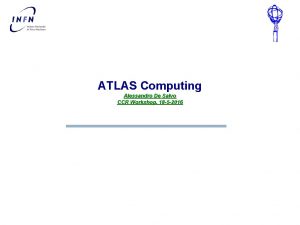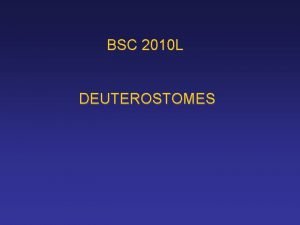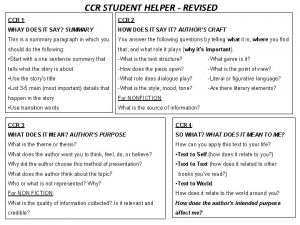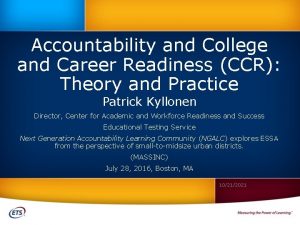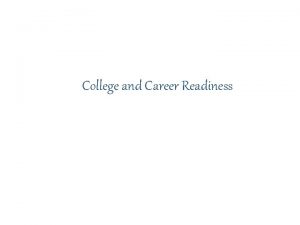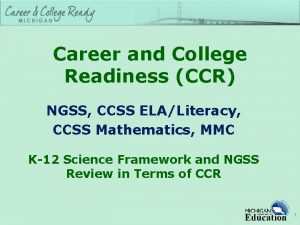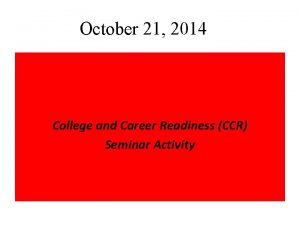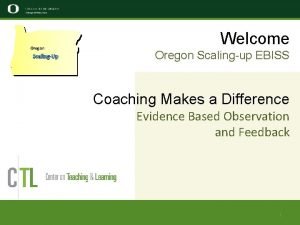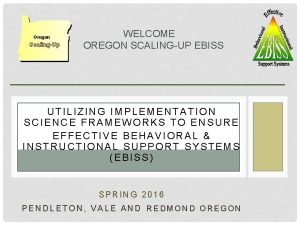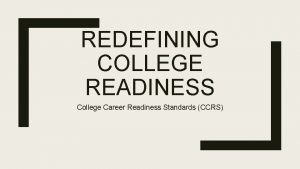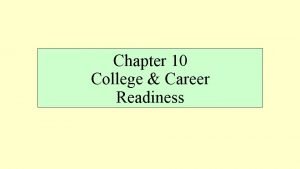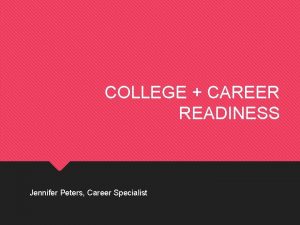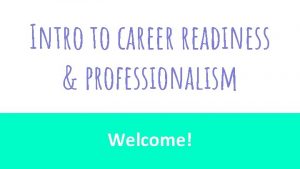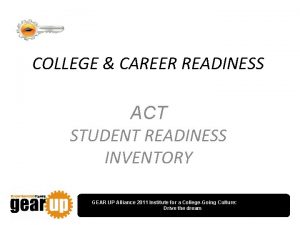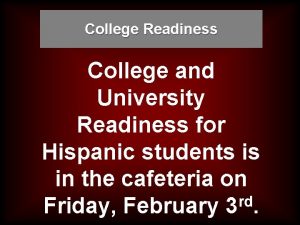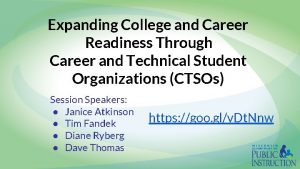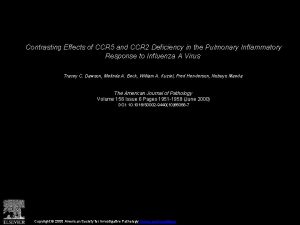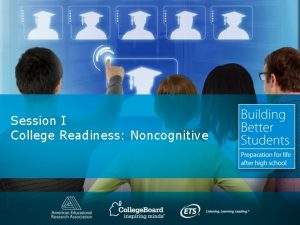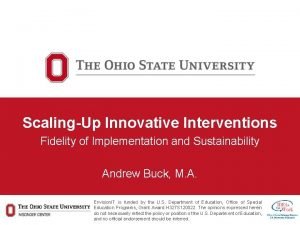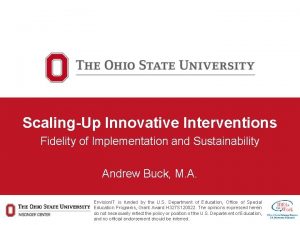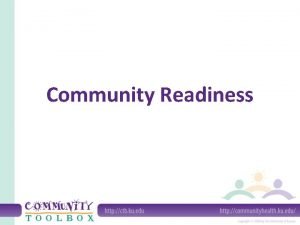ScalingUp College and Career Readiness CCR Interventions with



























- Slides: 27

Scaling-Up College and Career Readiness (CCR) Interventions with Technology Allison Lombardi, Ph. D University of Connecticut Margo Vreeburg Izzo, Ph. D Andrew Buck, MA Ohio State University

2015 -2016 Team • Margo Izzo, Principal Investigator • Alexa Murray, Andrew Buck, Kristin Page, Victor Johnson, Ohio State team • Patricia Anderson, CT State Dept of Education • Missy Wrigley, CT SERC • Allison Lombardi, Uconn • Nick Gelbar, UConn UCEDD • Jessica Monahan, Graham Rifenbark, UConn

Scaling-Up Effort • OSEP funded project to Ohio State • CT named partner state in 2014 • Tasked to scale-up and sustain Envision. IT curriculum

The Envision. IT (EIT) Curriculum • Designed for students in grades 8 -12 • Teach information technology (IT) literacy skills • Help students build a self-directed Transition Portfolio

The EIT Curriculum • Match student interests, abilities, and personality to career goals • Align with Common Core State Standards (CCSS) in ELA and national standards in IT literacy, career development, and financial literacy • Emphasizes “T” in STEM learning

Common Core Standards Information Technology & Computer Literacy Transition Assessment & Self. Directed Planning

ESSA Definition of Digital Learning Every Student Succeeds Act (ESSA) 21 U. S. C. 812(c) (3) Digital learning means any instructional practice that effectively uses technology to strengthen a student’s learning experience and encompasses a wide spectrum of tools and practices, including the following:

ESSA Definition of Digital Learning (2) a) Interactive learning resources b) Access to online databases c) Use of data and information to personalize learning d) Online and computer-based assessments e) Collaboration and communication f) Hybrid or blended learning g) Courses for students in different locations

ESSA and EIT Alignment EIT meets ESSA criteria through content and delivery: a) Schoology LMS allows for interactive learning b) Students connect with databases such as College Navigator c) Students take online age-appropriate assessments such as the VARK and O*NET Interest Profiler to help shape their career goals d) Students can use blog feature in Schoology e) EIT well-suited for blended learning where the teacher instructs and leads students through the digital content f) EIT can be accessed from Schoology and Google Documents and is compatible with computers, tablets, and smart phones g) Though Internet-based many activities can be printed off and require collaborative learning

Alignment to National Standards • Envision. IT is aligned to national standards for: – English Language Arts (Common Core State Standards) – Information and Communication Technology (Technology and Engineering Literacy) – Financial Literacy (National Standards in K-12 Personal Finance Education/Jump$tart) – Transition (National Standards and Quality Indicators for Secondary Education and Transition - NASET)

CT CORE Transition Skills CT CORE Transition Skill Envision. IT Objective B. Utilize effective self-determination skills including areas such as: choice-making, problem-solving, goal-setting, communication and self-advocacy TR 4 a. Ability to define and incorporate the S. M. A. R. T. Goals strategy to write postsecondary employment and education goals for Career Plan A and Career Plan B according to the S. M. A. R. T. goal framework. C. Strengthen his/her self-esteem and socialemotional awareness by analyzing his/her strengths and challenges in order to implement personal/vocational goals TR 3 a. Considering prior self-assessment results, select two careers based on student’s interests and strengths preferences. Ability to identify through OOH the occupational group/industry to which these careers belong. D. Assist with the development of his/her Individualized Education Program (IEP) TR 3 b. Ability to complete career selfassessment in O*Net and compare list of recommended careers with student’s two selfselected careers.

CT CORE Transition Skills CT CORE Transition Skill Envision. IT Objective L. Demonstrate skills to access TR 6 a. Ability to research financial aid appropriate postsecondary education, programs to help pay for education or training, or lifelong learning opportunities training in Career Plan A and B. to meet his/her individual needs M. Demonstrate skills to access TR 7 c. Ability to revise draft resume based appropriate employment to meet his/her on feedback from group discussion. individual needs P. Demonstrate the ability to use technology to enhance employment, learning, and community involvement ICT 10 a. Ability to use what you have learned to search the Internet for job interview questions.

Transition Portfolio 1. Title Page 2. Bookmarks of Career Search Websites 3. Self-Assessment Results 4. Career Comparison Table 5. Postsecondary Goals for 2 Career Plans 6. Postsecondary School Comparison Table 7. Transition Preparation Checklist

Transition Portfolio (2) 8. Career Essay 9. High School Course Schedule 10. Resume 11. Cover Letter 12. Job and College Application 13. Interview with a Professional 14. Power. Point or Digital Presentation

Connecticut • State partner as of 2014 • 3 -Year Scale-Up plan • Partnership between UConn, CT State Department of Education, SERC • Implemented in high schools • Implemented in various courses: Careers, Vocational Education, ELA (9 th grade at risk)

Ohio • Implemented in urban, suburban, and rural high schools • Implemented in various courses: Freshman Seminar, Postsecondary Planning

Sample • Today we focus on Year 3 and 4 findings from a pre/post quasi-experimental design – Includes 18 teachers from 10 secondary schools in OH and CT who participated in Year 3 (2014 -15) and the first semester of Year 4 (2015 -16). – 11 teachers implemented the curriculum (intervention group, n = 235) and 7 teachers did not implement (comparison group, n = 120). – Intervention group: 49% of students were on IEPs, 3% were on 504 plans, and 35% did not have a documented disability (with 13% missing data). – Comparison group: 51% of students were on IEPs, 3% on 504 plans, and 45% did not have a documented disability (with 5% missing data).

Method • RQ 1: What is the effect of Envision. IT on reading? • RQ 2: Does this effect differ by grade? • RQ 3: Does this effect differ by length of class (semester or year)? • Intervention and comparison group students were administered the AIMSweb 8 th grade Reading Maze before and after the curriculum as a pre and post test.

Method (2) • Students (level-1) were nested within teachers (level-2) • Dependent variable= difference score on AIMSweb representing change in reading achievement from pre to post. • Multilevel Linear Modeling (MLM; Snijders & Bosker, 1999) was utilized • To test this assumption a random effects analysis of variance model was estimated so that the intraclass correlation coefficient (ICC; ρ) – representing the proportion of variance between teachers – could be calculated. • Approximately 13% of the variance in AIMSweb difference scores was found between teachers (level-2)

Descriptive Statistics of Study Outcome By Intervention Status Intervention Variable Pre-Intervention n aimsweb 8 Post-Intervention 223 23. 68 10. 42 210 26. 03 11. 11 aimsweb 8 M Intervention SD Comparison n Comparison M SD 115 30. 13 11. 12 97 31. 18 12. 61 Key findings: There is a trend level increase in the difference scores (post-pre) for both groups, although greater for the intervention group

Fixed Effects Estimates (Top) and Variance-Covariance Estimates (Bottom) for Final Model of the Effectiveness of Envision. IT on Aims. Web 8 th scores Parameter Intercept Level 1 - Student Length of Class Lunch 10 th Grade 11 th Grade 12 th Grade Level 2 - Teacher Envision. IT Final Model Fixed Effects -3. 40 (1. 43) -0. 99 (1. 96) 0. 88 (0. 83) 1. 45 (1. 76) 3. 88* (1. 64) 3. 11 (2. 19) 3. 11* (1. 31) requivalent pr 0. 55 0. 03 0. 06 0. 05 0. 14 0. 08 0. 55 Level 2 Intercept (τ00) Level 1 Intercept (σ2) -2*log likelihood Random Parameters 2. 86 (1. 86) 39. 13 (3. 36) 1852. 2 0. 39 0. 57 Key findings: There was a significant and large effect of EIT on reading scores (r =. 55) The effect was significant when controlling for free and reduced price lunch and length of the curriculum (Semester or Year)

Grade 9 th 10 th 11 th 12 th Comparison Intervention Group, Not Eligible for FLS, Semester Results (2) -3. 403 -1. 953 0. 472 -0. 290 1. 160 3. 585 2. 823 Note. Predicted change in aimsweb 8 score from pre to post FLS= free and reduced price lunch Key findings: Intervention group students showed greater change in AIMSweb 8 th scores regardless of grade level.

40. 0 AIMS web 8 th grade MAZE 36. 6 35. 0 30. 4 Score 30. 0 25. 0 26. 0 25. 8 Results (3) 10 th grade Intervention (n = 35) 9 th grade Intervention (n = 17) 9 th grade Comparison (n = 22) 20. 0 17. 7 18. 5 15. 0 Pre CT sample from Fall 2015 represented in this graph Post EIT features embedded literacy strategies, which might make a difference in maintaining reading levels into the high school grades

Schoology 38

Additional Resources EIT Student Videos: http: //go. osu. edu/eitvideos EIT Teacher Training Videos: http: //go. osu. edu/eitpd OSU Nisonger Center EIT Website: http: //go. osu. edu/eit UCONN Neag School of Education: http: //education. uconn. edu/ Univ of Rochester Institute for Innovation Transition http: //www. nytransition. org/ 40

Guided Discussion • How is digital literacy and/or reading being promoted in high schools in your state? • Are students with disabilities included in these efforts? • How is digital literacy and/or reading embedded into transition services within secondary special education?

Questions? Margo Izzo, Principal Investigator Margo. Izzo@osumc. edu Allison Lombardi, Project Coordinator in CT allison. lombardi@uconn. edu Andrew Buck, Program Manager for OH Andrew. Buck@osumc. edu
 Reading counts levels
Reading counts levels College lexile
College lexile Vocabulary power plus for college and career readiness
Vocabulary power plus for college and career readiness College and career readiness standards math
College and career readiness standards math Wake tech admissions
Wake tech admissions Misconceptions about career assessment
Misconceptions about career assessment Sahs aspire
Sahs aspire National career readiness certificate
National career readiness certificate Chapter 6 career readiness chapter review
Chapter 6 career readiness chapter review Win courseware
Win courseware Career readiness self assessment
Career readiness self assessment Career readiness checklist
Career readiness checklist Career readiness survey
Career readiness survey Ccr & ccd development
Ccr & ccd development Brain parts
Brain parts Ccap illinois
Ccap illinois Whitely v chappel (1868)
Whitely v chappel (1868) Advantages of statutory interpretation
Advantages of statutory interpretation Approaches to interpretation
Approaches to interpretation فلونوكس
فلونوكس Small dynamic business search from the ccr home page
Small dynamic business search from the ccr home page Ccr hometown
Ccr hometown Nagra com
Nagra com R v allen (1872) lr 1 ccr 367
R v allen (1872) lr 1 ccr 367 Naviance hisd
Naviance hisd Atlas ccr
Atlas ccr Ccr
Ccr Lungfish ccr
Lungfish ccr
